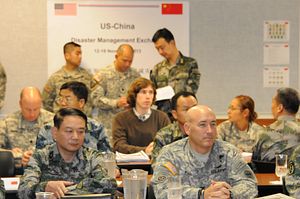On November 19, a ceremony at Fort Hamilton in New York City marked the formal conclusion of a joint drill between the U.S. and Chinese militaries. The drill, which began in Hawaii on November 12, was an exercise in joint humanitarian aid and disaster relief. Under the training scenario, troops from the U.S. and China practiced providing emergency aid to a third country that had suffered a severe earthquake. The drill was one of the largest yet held between the two countries, and provided a rare opportunity for joint field exercises.
In the past few years, joint humanitarian drills have encouraged cooperation between two militaries that increasingly distrust one another. Joint training in humanitarian assistance and disaster relief (HA/DR) provides an unobjectionable way for the two militaries to engage with one another. Engagement leads to understanding, which is the basis for mutual trust — or so the theory goes.
Both President Obama and President Xi Jinping recognize the need for military-to-military relations between the U.S. and China. Xi Jinping has made it clear that his vision of new type major power relations included “a new model of military relationship between the two sides.”
As a result, there have been a number of high-profile military exchange visits between the U.S. and China in past year. General Martin Dempsey, Chairman of the Joint Chiefs of Staff, made a trip to Beijing in April, where he highlighted the United States’ commitment to deeper military-to-military relations. Chinese Defense Minister Chang Wanquan also visited the United States in August. U.S. Secretary of Defense Chuck Hagel and PLA Chief of General Staff Fang Fenghui are expected to exchange visits in 2014.
Official visits can only go so far, however. There remains a large trust deficit between the two countries. Joint military exercises help combat this distrust by allowing the militaries to engage one another at the grassroots level. Such drills involve the interaction of troops, not just senior officials. The hope is that such interactions can encourage military-to-military relations from the bottom up, rather than solely relying on the top-heavy format of high-level visits. Ideally, joint exercises will help build up cooperation and even trust between the United States and China. However, precisely because they distrust one another, the U.S. and Chinese militaries have been reluctant to engage in joint drills.
Humanitarian exercises provide an escape from this catch-22, which is why they have become such a crucial part of U.S.-China relations. The annual Defense Consultative Talks in Beijing this year listed four areas for cooperation: “humanitarian assistance, disaster relief, peacekeeping, and maritime safety.” The U.S. and Chinese governments have wasted no time implementing the suggestion. Besides this week’s exercises, the U.S. and Chinese navies combined forces for a search and rescue drill in August 2013. Realistically, such drills are unlikely to make a serious dent in the strategic mistrust between the two militaries. But by providing a benign area for cooperation, the drills let U.S. and Chinese troops interact on a personal level. It’s a small step towards humanizing people who are otherwise seen as rivals.
In addition to providing a forum for military-to-military relations, the joint humanitarian exercises could also provide benefits to the region at larger. Imagine if the U.S. and China could begin to coordinate disaster responses to catastrophes like Typhoon Haiyan. If the two countries can reach that level of trust, the entire Asia-Pacific region will reap the benefits.

































